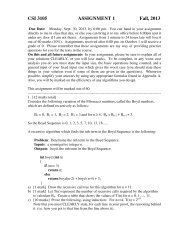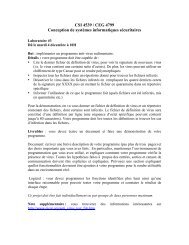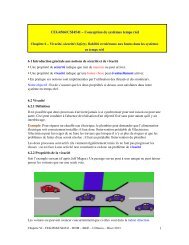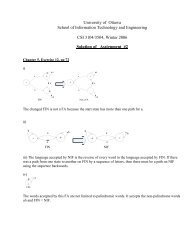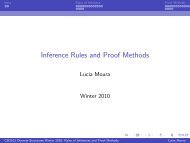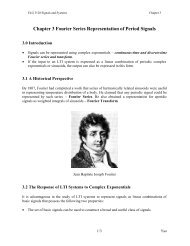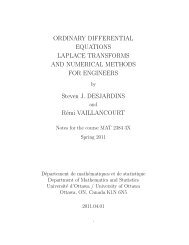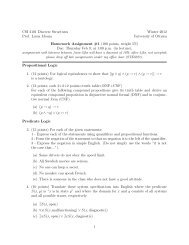CSI 2101 Discrete Structures Winter 2012 Prof. Lucia Moura ...
CSI 2101 Discrete Structures Winter 2012 Prof. Lucia Moura ...
CSI 2101 Discrete Structures Winter 2012 Prof. Lucia Moura ...
Create successful ePaper yourself
Turn your PDF publications into a flip-book with our unique Google optimized e-Paper software.
<strong>CSI</strong> <strong>2101</strong> <strong>Discrete</strong> <strong>Structures</strong> <strong>Winter</strong> <strong>2012</strong><br />
<strong>Prof</strong>. <strong>Lucia</strong> <strong>Moura</strong> University of Ottawa<br />
Homework Assignment #1 (100 points, weight 5%)<br />
Due: Thursday Feb 9, at 1:00 p.m. (in lecture);<br />
assignments with lateness between 1min-24hs will have a discount of 10%; after 24hs, not accepted;<br />
please drop off late assignments under my office door (STE5027).<br />
Propositional Logic<br />
1. (12 points) Use logical equivalences to show that [(p ∨ q) ∧ (p → r) ∧ (q → r)] → r<br />
is a tautology.<br />
It is sufficient to show that if we assume the premise (p ∨ q) ∧ (p → r) ∧ (q → r), then<br />
we can derive the conclusion r. Here is such an argument:<br />
Thus, the statement is a tautology.<br />
1. p ∨ q Simplification<br />
2. p → r ≡ ¬p ∨ r Simplification<br />
3. q → r ≡ ¬q ∨ r Simplification<br />
4. q ∨ r Resolution (1) and (2)<br />
5. r ∨ r ≡ r Resolution (3) and (4)<br />
2. (12 points; each 2+2+2 points=truth table+DNF+CNF)<br />
For each of the following compound propositions give its truth table and derive an<br />
equivalent compound proposition in disjunctive normal formal (DNF) and in conjunctive<br />
normal form (CNF).<br />
(a) (p → q) → r<br />
We write out the truth table:<br />
p q r p → q (p → q) → r<br />
T T T T T<br />
T T F T F<br />
T F T F T<br />
T F F F T<br />
F T T T T<br />
F T F T F<br />
F F T T T<br />
F F F T F<br />
1
To get disjunctive normal form, we take the conjunction of the values for p, q, and<br />
r for each row where the final evaluation is T, and then take their disjunction:<br />
(p ∧ q ∧ r) ∨ (p ∧ ¬q ∧ r) ∨ (p ∧ ¬q ∧ ¬r) ∨ (¬p ∧ q ∧ r) ∨ (¬p ∧ ¬q ∧ r)<br />
To get conjunctive normal form, we take the conjunction of the values for p, q,<br />
and r for each row where the final evaluation is F, and then take their disjunction:<br />
(p ∧ q ∧ ¬r) ∨ (¬p ∧ q ∧ ¬r) ∨ (¬p ∧ ¬q ∧ ¬r)<br />
Now we take the negation of this entire expression, and repeatedly using DeMorgan’s,<br />
we derive:<br />
(b) (p ∧ ¬q) ∨ (p ↔ r)<br />
We write out the truth table:<br />
(¬p ∨ ¬q ∨ r) ∧ (p ∨ ¬q ∨ r) ∧ (p ∨ q ∨ r)<br />
p q r p ∧ ¬qq p ↔ r (p ∧ ¬q) ∨ (p ↔ r)<br />
T T T F T T<br />
T T F F F F<br />
T F T T T T<br />
T F F T F T<br />
F T T F F F<br />
F T F F T T<br />
F F T F F F<br />
F F F F T T<br />
To get disjunctive normal form, we take the conjunction of the values for p, q, and<br />
r for each row where the final evaluation is T, and then take their disjunction:<br />
(p ∧ q ∧ r) ∨ (p ∧ ¬q ∧ r) ∨ (p ∧ ¬q ∧ ¬r) ∨ (¬p ∧ q ∧ ¬r) ∨ (¬p ∧ ¬q ∧ ¬r)<br />
To get conjunctive normal form, we take the conjunction of the values for p, q,<br />
and r for each row where the final evaluation is F, and then take their disjunction:<br />
(p ∧ q ∧ ¬r) ∨ (¬p ∧ q ∧ r) ∨ (¬p ∧ ¬q ∧ r)<br />
Now we take the negation of this entire expression, and repeatedly using DeMorgan’s,<br />
we derive:<br />
(¬p ∨ ¬q ∨ r) ∧ (p ∨ ¬q ∨ ¬r) ∧ (p ∨ q ∨ ¬r)<br />
2
Predicate Logic<br />
3. (15 points) For each of the given statements:<br />
1 - Express each of the statements using quantifiers and propositional functions.<br />
2 - Form the negation of the statement so that no negation is to the left of the quantifier.<br />
3 - Express the negation in simple English. (Do not simply use the words “it is not<br />
the case that...”).<br />
(a) Some drivers do not obey the speed limit.<br />
Let the domain be the domain of drivers, and let S(x) be the predicate “x obeys<br />
the speed limit.” Then the statement can be written ∃x¬S(x), and the negation<br />
is ¬∃x¬S(x) ≡ ∀xS(x), or, in English, all drivers obey the speed limit.<br />
(b) All Swedish movies are serious.<br />
Let the domain be the domain of Swedish movies, and let M(x) be the predicate<br />
“x is serious.” Then the statement can be written ∀xM(x), and the negation is<br />
¬∀xM(x) ≡ ∃x¬M(x), or, in English, some Swedish movie is not serious.<br />
(c) No one can keep a secret.<br />
Let the domain be the domain of all people, and let K(x) be the predicate “x<br />
can keep a secret.” The statement can be written ¬∃xK(x) ≡ ∀x¬K(x). The<br />
negation is ∃xK(x), or, in English, someone can keep a secret.<br />
(d) No monkey can speak French.<br />
Let the domain be the domain of all monkeys, and let F (x) be the predicate “x<br />
can speak French.” The statement can be written ¬∃xF (x) ≡ ∀x¬F (x). The<br />
negation is ∃xF (x), or, in English, some monkey can speak French.<br />
(e) There is someone in the class who does not have a good attitude.<br />
Let the domain be everyone in the class, and let A(x) be the predicate “x has a<br />
good attitude’.” The statement can then be written ∃x¬A(x). The negation is<br />
¬∃x¬A(x) ≡ ∀xA(x), or, in English, everyone in the class has a good attitude.<br />
4. (10 points) Translate these system specifications into English where the predicate<br />
S(x, y) is “x is in state y” and where the domain for x and y consists of all systems<br />
and all possible states, respectively.<br />
3
(a) ∃S(x, open)<br />
Some system is open.<br />
(b) ∀x(S(x, malfunctioning) ∨ S(x, diagnostic))<br />
Every system is either malfunctioning or in diagnostic mode.<br />
(c) ∃xS(x, open) ∨ ∃xS(x, diagnostic)<br />
Either some system is open, or some system is in diagnostic mode.<br />
(d) ∃x¬S(x, available)<br />
Some system is not available.<br />
(e) ∀x¬S(x, working)<br />
No system is working.<br />
5. (3+3+3+3=12 marks) Rewrite the following statments statements so that all negation<br />
symbols immediately precede predicates (that is, no negation is outside a quantifier or<br />
an expression involving logical connectives). Show al the steps in your derivation.<br />
(a) ¬∀x∃yP (x, y)<br />
(b) ¬∃y(Q(y) ∧ ∀x¬R(x, y))<br />
(c) ¬∃y(∃xR(x, y) ∨ ∀xS(x, y))<br />
¬∀x∃yP (x, y) ≡ ∃x∀y¬P (x, y)<br />
¬∃y(Q(y) ∧ ∀x¬R(x, y)) ≡ ∀y¬(Q(y) ∧ ∀x¬R(x, y))<br />
≡ ∀y(¬Q(y) ∨ ∃xR(x, y))<br />
¬∃y(∃xR(x, y) ∨ ∀xS(x, y)) ≡ ∀y¬(∃xR(x, y) ∨ ∀xS(x, y))<br />
4<br />
≡ ∀y(¬∃xR(x, y) ∧ ¬∀xS(x, y))<br />
≡ ∀y(∀x¬R(x, y) ∧ ∃x¬S(x, y))
(d) ¬∃y(∀x∃zT (x, y, z) ∨ ∃x∀zU(x, y, z))<br />
¬∃y(∀x∃zT (x, y, z) ∨ ∃x∀zU(x, y, z)) ≡ ∀y¬(∀x∃zT (x, y, z) ∨ ∃x∀zU(x, y, z))<br />
≡ ∀y(¬∀x∃zT (x, y, z) ∧ ¬∃x∀zU(x, y, z))<br />
≡ ∀y(∃x∀z¬T (x, y, z) ∧ ∀x∃z¬U(x, y, z))<br />
6. (10 points) Prove these logical equivalences, assuming that the domain is nonempty.<br />
You will probably have to use a proof by cases on the two possible values of proposition<br />
∀yQ(y) and ∃yQ(y) respectively. This proof will use word arguments (not symbolic<br />
formula manipulation).<br />
(a) ∀x(∀yQ(y) → P (x)) ≡ ∀yQ(y) → ∀xP (x)<br />
We break into two cases depending on the truth value of ∀xQ(x).<br />
If ∀xQ(x) is true, we have that:<br />
∀x (T → P (x))<br />
≡ ∀x (¬T ∨ P (x)) Table 7<br />
≡ ∀x (F ∨ P (x))<br />
≡ ∀x P (x) domination<br />
T → ∀x P (x)<br />
≡ ¬T ∨ ∀x P (x) Table 7<br />
≡ F ∨ ∀x P (x)<br />
≡ ∀x P (x) domination<br />
Thus, if ∀xQ(x) is true, the statements are equivalent.<br />
If ∀xQ(x) is false, we have that:<br />
∀x (F → P (x))<br />
≡ ∀x (¬F ∨ P (x)) Table 7<br />
≡ ∀x (T ∨ P (x))<br />
≡ ∀x T domination<br />
≡ T<br />
F → ∀x P (x)<br />
≡ ¬F ∨ ∀x P (x) Table 7<br />
≡ T ∨ ∀x P (x)<br />
≡ T domination<br />
Thus, if ∀xQ(x) is false, both statements are true, and thus equivalent.<br />
As they are equivalent regardless of the value of ∀xQ(x), the two statements are<br />
logically equivalent.<br />
5
(b) ∃x(∃yQ(y) → P (x)) ≡ ∃yQ(y) → ∃xP (x)<br />
We break into two cases depending on the truth value of ∃xQ(x).<br />
If ∃xQ(x) is true, we have that:<br />
∃x (T → P (x))<br />
≡ ∃x (¬T ∨ P (x)) Table 7<br />
≡ ∃x (F ∨ P (x))<br />
≡ ∃x P (x) domination<br />
T → ∃x P (x)<br />
≡ ¬T ∨ ∃x P (x) Table 7<br />
≡ F ∨ ∃x P (x)<br />
≡ ∃x P (x) domination<br />
Thus, if ∃xQ(x) is true, the statements are equivalent.<br />
If ∃xQ(x) is false, we have that:<br />
∃x (F → P (x))<br />
≡ ∃x (¬F ∨ P (x)) Table 7<br />
≡ ∃x (T ∨ P (x))<br />
≡ ∃x T domination<br />
≡ T<br />
F → ∃x P (x)<br />
≡ ¬F ∨ ∃x P (x) Table 7<br />
≡ T ∨ ∃x P (x)<br />
≡ T domination<br />
Thus, if ∃xQ(x) is false, both statements are true, and thus equivalent.<br />
As they are equivalent regardless of the value of ∃xQ(x), the two statements are<br />
logically equivalent.<br />
7. (10 points) A statement is in prenex normal form (PNF) if and only if all quantifiers<br />
occur at the beginning of the statement (without negations), followed by a predicate<br />
involving no quantifiers. Put the following statement in prenex normal form:<br />
(Hint: your first step should rename one of the two x’s as y; check useful valid equivalences<br />
in exercises 48,49 page 62 of 6th edition)<br />
(a) ∃xP (x) ∨ ∃xQ(x) ∨ A, where A is a proposition not involving any quantifiers.<br />
We rewrite the statement ∃xP (x) ∨ ∃yQ(y) ∨ A. Now, by 49(b), we can write<br />
(∃x∃y(P (x) ∨ Q(y)) ∨ A. Since A does not contain either the variable x or y,<br />
we can move it inside the parentheses and write: ∃x∃y(P (x) ∨ Q(y) ∨ A). This<br />
6
statement is in PNF. Note that changing the name of the variable is not necessary,<br />
as ∃xP (x) ∨ ∃xQ(x) ≡ ∃x(P (x) ∨ Q(x)), as per S1.3 exercise 45. Thus, the final<br />
answer could also be ∃x(P (x) ∨ Q(x) ∨ A).<br />
(b) ∃xP (x) → ∃xQ(x)<br />
We first rename the variable on the right hand side as y to get ∃xP (x) → ∃yQ(y).<br />
We rewrite the statement by reinterpreting implication as ¬∃xP (x) ∨ ∃yQ(y)).<br />
Then by moving the negation in front of the predicate P (x) gives us ∀x¬P (x) ∨<br />
∃yQ(y). Now by 49(b), we can rewrite this as ∀x∃y(¬P (x) ∨ Q(y)), which is in<br />
PNF as required.<br />
Rules of Inference<br />
8. (9 points) For each of these arguments, determine whether the argument is correct or<br />
incorrect and explain why.<br />
(a) Everyone born in Ottawa has eaten a beaver tail. Susan has never eaten a beaver<br />
tail. Therefore Susan was not born in Ottawa.<br />
If we let B(x) be the predicate “x was born in Ottawa”, and E(x) be the predicate<br />
“x has eaten a beaver tail”, and the domain be the domain of all people, then<br />
the argument as given is (∀x(B(x) → E(x)) ∧ ¬E(Susan)) → ¬B(Susan). This<br />
is just an application of modus tollens, and thus, the argument is correct.<br />
(b) A convertible car is fun to drive. Joe’s car is not a convertible. Therefore, Joe’s<br />
car is not fun to drive.<br />
Let the domain be the domain of all cars, and let C(x) be the predicate “x is a<br />
convertible” and F (x) be the predicate “x is fun to drive.” Then the argument as<br />
stated is (∀x(C(x) → F (x)) ∧ ¬C(Joe’s car)) → ¬F (Joe’s car). This argument<br />
is not true, and it is the fallacy of denying the antecedent: being a covertible is<br />
a sufficient condition for being fun to drive, but it is not a necessary condition.<br />
Thus, we cannot derive any information about whether or not Joe’s car is fun to<br />
drive from the premises.<br />
(c) Emma likes all fine restaurants. Emma likes the restaurant “Le Cordon Bleu”.<br />
Therefore, “Le Cordon Bleu” is a fine restaurant.<br />
Let the domain be the domain of all restaurants, and let F (x) be the predicate “x<br />
is a fine restaurant” and L(x) be the predicate “Emma likes x.” Then the argument<br />
as stated is (∀x(F (x) → L(x))∧F (Le Cordon Bleu)) → L(Le Cordon Bleu).<br />
7
This argument is not true, and is the fallacy of confirming the consequent: Emma<br />
liking a restaurant is a necessary condition for a restaurant to be a fine restaurant,<br />
but it is not sufficient. Thus, we cannot conclude from the premises whether or<br />
not Le Cordon Bleu is a fine restaurant.<br />
9. (10 points) Give a formal proof, using known rules of inference, to establish the conclusion<br />
of the argument (3rd statement) using the first 2 statements as premises, where<br />
the domain of all quantifiers is the same.<br />
Remember that a formal proof is a sequence of steps, each with a reason noted beside<br />
it; each step is either a premise, or is obtained from previous steps using inference<br />
rules.<br />
• premise: ∀x(P (x) ∨ Q(x))<br />
• premise: ∀x((¬P (x) ∧ Q(x)) → R(x))<br />
• conclusion: ∀x(¬R(x) → P (x))<br />
Here is one possible formal proof:<br />
1. ∀x(P (x) ∨ Q(x)) premise<br />
2. ∀x((¬P (x) ∧ Q(x)) → R(x)) premise<br />
3. P (a) ∨ Q(a) for arbitrary a universal instantiation (1)<br />
4. (¬P (a) ∧ Q(a)) → R(a) universal instantiation (2)<br />
5. ¬(¬P (a) ∧ Q(a)) ∨ R(a) logical equivalence (4)<br />
6. (P (a) ∨ ¬Q(a)) ∨ R(a) DeMorgan (5)<br />
7. ¬Q(a) ∨ (P (a) ∨ R(a)) logical equivalence (6)<br />
8. P (a) ∨ (P (a) ∨ R(a)) resolution (3) and (7)<br />
9. P (a) ∨ R(a) idempotency (8)<br />
10. R(a) ∨ P (a) logical equivalence (9)<br />
11. ¬R(a) → P (a) for arbitrary a logical equivalence (10)<br />
12. ∀x(¬R(x) → P (x)) universal generalization (11)<br />
8



